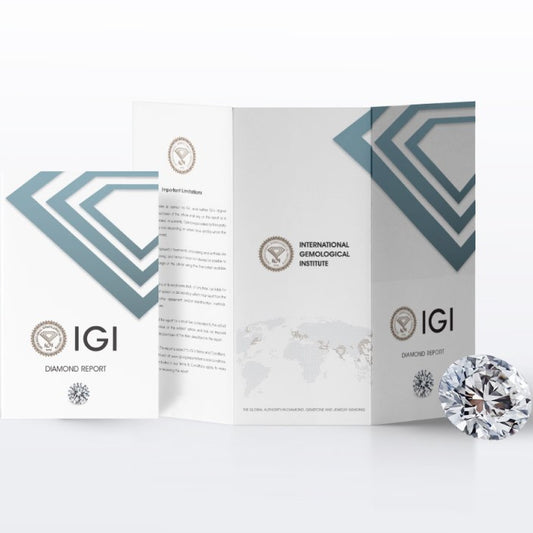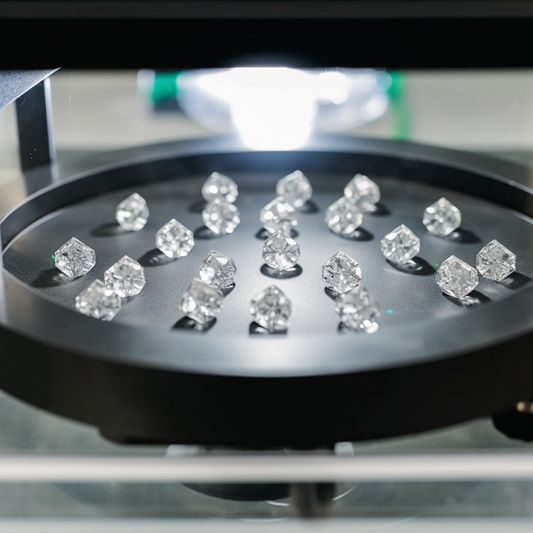While the terms “synthetic” and “simulated” may sound similar, a comparison between simulated vs. synthetic diamonds quickly reveals that they are two completely different things. It's important to know what a simulated diamond is and how it differs from a synthetic diamond, especially when shopping for timeless jewelry such as an engagement ring.
In this guide, we'll tell you all about the benefits of lab-simulated diamonds and how they compare to the real thing. We'll also compare some of the most popular types of simulated and synthetic diamonds on the market so you can better understand which is most suitable for your perfect engagement ring (or any other jewelry your heart may desire).
Simulated Diamond Composition: Are Simulated Diamonds Real?
Let's start with the basics. What is a simulated diamond? And what makes a simulated diamond different from a synthetic one? Synthetic diamonds, also known as lab-grown diamonds, have the same chemical composition—pure carbon—as real diamonds mined from the earth, while simulated diamonds have a similar composition to diamonds but it’s not exactly the same.
This is an essential difference because it answers the often-asked question: are simulated diamonds real? Simulated diamonds are real in the sense that they are real gemstones, but they don't have the exact same chemical composition as lab-grown synthetic or natural diamonds made by Mother Nature.
In nature, with high temperature and pressure, diamonds form as crystals. This is the same process that both simulated and synthetic diamonds undergo in the laboratory, but only has the exact same composition as the real thing.
Simulated Diamond Materials: What Is a Simulated Diamond Made Of?
Simulated diamond rings and earrings have materials that are similar to those of naturally occurring diamonds. Instead of pure carbon, as in synthetic lab-grown diamonds and natural diamonds, simulated diamonds are made of different chemical compositions, such as silicon carbide in the case of moissanite. Both of these substances are extremely hard, which makes either a synthetic diamond or a simulated diamond suitable for the rigors of everyday wear. This is particularly important to consider when choosing an engagement ring.
Simulated Diamond vs. Cubic Zirconia
Within the world of simulated diamonds, there are quite a few varieties and not all are created the same. Therefore, it's important to understand the different types available and the features of each. Some are more desirable than others in terms of quality and durability.
Hardness
Color
Diamonesk vs. Cubic Zirconia
You've likely heard about cubic zirconia and diamonesk before, but what is a diamonesk stone’s benefits and drawbacks when compared to cubic zirconia? Diamonesk is a proprietary brand of simulated diamond exclusive to the brand The Bradford Exchange. Both cubic zirconia and diamonesk are among the least costly of the diamond simulants, but don't boast the premium properties of moissanite.
Simulated vs. Synthetic Diamonds
Let's look at a brief overview of the main differences when comparing synthetic and simulated diamonds:
- Synthetic diamonds have the same optical, physical and chemical properties as a natural diamond, except they are grown in a lab rather than mined. This makes it more sustainable than a real diamond.
- Simulated diamonds have the same optical and physical properties as a natural diamond, making them nearly indistinguishable from diamonds mined from the earth; however, their chemical composition is not the same as a natural diamond and varies among the different types of simulated diamonds. Simulated diamonds are also a more sustainable choice.
Why Choose Simulated Diamond Rings
When it comes to choosing the perfect engagement ring with a diamond alternative, simulated diamond rings are hard to beat. They’re more affordable and some varieties are even more sparkly and brilliant than natural diamonds. Simulated diamond rings often have nearly the same hardness as natural diamonds, making them an excellent choice for engagement rings.
Find Your Perfect Engagement Ring
Your special someone deserves to feel special, so make sure to give them something special. Many people are turning to simulated diamond gemstones, such as moissanite, for a beautiful and ethical alternative to naturally mined diamonds. Shop the gorgeous selection of conflict-free and environmentally conscious moissanite engagement rings at Gema&Co to discover all the beauty of this diamond alternative.



